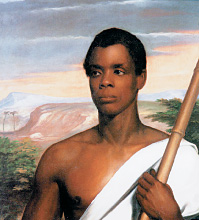‘The captives are freed’
 |
| In a Sept. 6, 1839, Journal of Commerce article, Lewis
Tappan described Cinque, the leader of the slaves who
seized the Amistad, as being "about 5 feet, 8 inches
high, of fine proportions, with a noble air." |
Lewis and Arthur Tappan, along with the JoC,
played a leading role in freeing captive Africans
In Hollywood’s version of the 1839 mutiny aboard the Amistad slave ship and the two-year fight for the imprisoned slaves’ freedom, brothers Lewis and Arthur Tappan were depicted as supporting characters in the drama. In real life, the roles of the Tappans and The Journal of Commerce were anything but secondary.
The Amistad case was a natural for the Tappan brothers. Besides being key figures in the early years of the JoC, both men were devout abolitionists. Lewis Tappan saw the Amistad case as a “Providential occurrence” — an opportunity not only to help the captured Africans who had seized the ship, but to dramatize the evils of the slave trade. He organized the Amistad Committee to raise money for the captives’ legal defense and to sustain them while in custody.
The Journal of Commerce helped keep the case in the public spotlight. What “might have ended up quietly in a prize court in Connecticut” became “a cause celebre for the abolition movement,” wrote Howard Jones, author of “Mutiny on the Amistad.”
The Amistad saga began when slaves aboard the ship revolted to secure their freedom while being transported from one Cuban port to another. Their leader was Sgngbe Pieh, popularly known in U.S. history as Joseph Cinque. He used a loose spike he had removed from the deck to unshackle himself and his fellow slaves. They killed the Spanish ship’s captain and a cook and took over the ship, ordering surviving seamen to sail eastward toward Africa.
"The captives are freed! Thanks,
thanks in the name of humanity and of
justice, to YOU."
Former President
John
Quincy Adams |
A gale drove the ship northeast along the U.S. coastline for two months, during which eight slaves died of thirst and exposure. In August 1839, the vessel drifted off Long Island, N.Y., where it was taken into custody. In New London, Conn., the slaves were charged with piracy and murder.
The U.S. anti-slavery movement adopted the case. Lewis Tappan launched the campaign for the defense of the Amistad slaves. He hired lawyers and, after considerable searching, Africans who could help with interpretation. The case quickly became international, with Spain seeking to transport the slaves back to Cuba. Abolitionists stood watch in shifts at the New Haven jail to prevent the seizure of the Africans.
The legal case was complicated. One judge ruled that his court had no jurisdiction, since the alleged crimes were committed on a Spanish ship and in Spanish waters. After further sparring by lawyers, another judge ruled that the captives had been kidnapped and sold into slavery in violation of Spanish law, and that they were legally free and should be transported back to Africa.
The government appealed. The Amistad Committee, headed by Tappan, continued to pursue the Africans’ case while caring for the Amistad captives and instructing them in reading, writing and the doctrines of Christianity. The JoC, meanwhile, reported every development.
Lewis Tappan prevailed on former President John Quincy Adams to take the case, which he argued for 4 1/2 hours before the U.S. Supreme Court. On March 9, 1841, the high court upheld the lower court’s ruling, and declared the captives free.
Adams immediately sent word to Lewis Tappan: “The captives are freed! Thanks, thanks in the name of humanity and of justice, to YOU.” |

